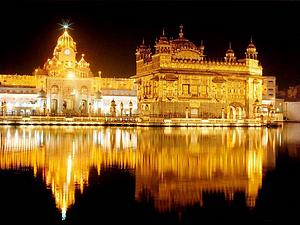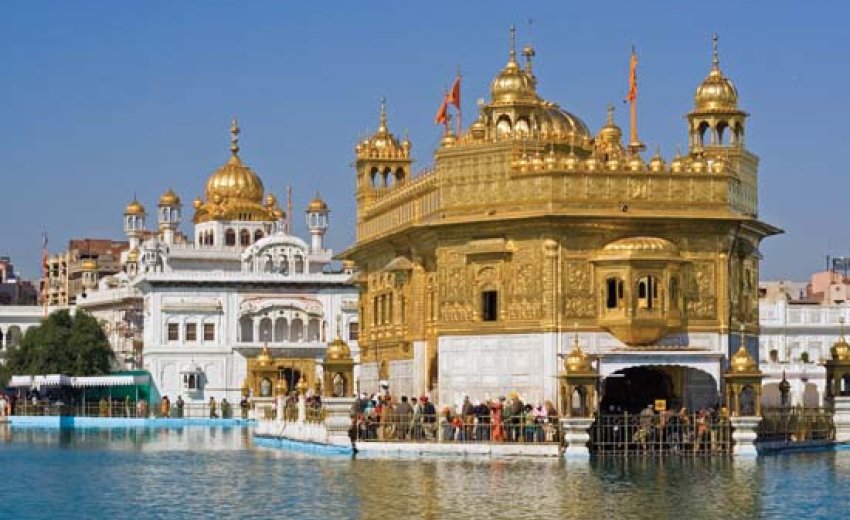 One of the most recognizable pieces of religious architecture in the world is the Golden Temple in Amritsar, India, the most significant place of worship of the Sikhs. The upper part of this ornate rectangular marble structure is covered in gold. I saw the gleaming temple early in the morning, before sunrise, when it was bathed in soft artificial light. It stood immovable as a huge gilded rock, its reflected image dancing gently on the surface of the surrounding pool.
One of the most recognizable pieces of religious architecture in the world is the Golden Temple in Amritsar, India, the most significant place of worship of the Sikhs. The upper part of this ornate rectangular marble structure is covered in gold. I saw the gleaming temple early in the morning, before sunrise, when it was bathed in soft artificial light. It stood immovable as a huge gilded rock, its reflected image dancing gently on the surface of the surrounding pool.
I was in Amritsar as a Christian consultant for a meeting of the Elijah Board of World Religious Leaders, organized by my friend Rabbi Alon Goshen-Gottstein. I had written a position paper to serve as a basis for discussions that would include the Dalai Lama and the chief rabbi of Jerusalem. Six writers of position papers representing different world religions had discussed their drafts with one another and with a larger interfaith group of scholars. It was a fascinating exercise. As I was writing, I was aided by wisdom from other faith traditions. What I presented as genuinely my own was in part received from others.
I grew up solidly Protestant in an overwhelmingly Catholic and Orthodox environment controlled by aggressively secular communists. Unlike the communists, those in our Protestant tribe nurtured a sense of the holy. But we differed from the Catholics and the Orthodox in that for us holiness was not to be located in time and space. The eternal and omnipresent God was holy; people could be holy if they made themselves available for God; times and places were not holy. We did not follow a liturgical calendar closely, and we met for worship in remodeled rooms of an ordinary house on an ordinary street. As a child of a pastor, I lived in that house; the neighbor kids and I played soccer in its yard and marbles on the patch of dirt in front of it. As examples of sacred architecture, the places where I experienced God—in restless rebellion and not just in sweet surrender—were the polar opposites of the Golden Temple.
At the temple I walked barefoot and with covered head around the holy pool in which people took ritual baths. I observed the people quietly streaming to the temple and walking by the place where Sri Guru Granth Sahib Ji is kept, the holy book which ultimately makes the place holy. But I didn't feel spiritually pulled in. I was a sympathetic observer, learning, questioning, puzzling over things, appreciating. I remained an outsider, not a participant.
Yet I took with me something unforgettable, a nugget of enacted religious wisdom that I cherish more than I would a piece of that temple's gold.
The next day, as I walked one more time within the temple complex, I wanted to buy a souvenir for my two boys. Then it dawned on me: I hadn't seen a vendor or a shop anywhere on the temple premises. "Thousands of religious tourists mill around here every day," I thought. "There must be a place to buy souvenirs!" But there wasn't.
You had to leave the temple complex and step onto the profane ground of surrounding streets to satisfy your tourist appetite. There peddlers were as busy as anywhere else in the world, and I found what I was looking for—a small kirpan, a ritual sword that all baptized Sikh wear. But not on the holy site—there the only commercial transaction that took place was the purchase of a "ticket" to walk across the bridge to the temple in the middle of the lake. The ticket was a bowl of porridge, the size of which depended on how much you paid. You could eat some of it, but you were expected to put at least a portion of it into large bowls. When the bowls were filled, they were carried off to feed the poor.
The contrast between the Golden Temple and other religious sites I've seen could not be greater. Everywhere else, greedy people—often religious leaders with business managers—were trying to cash in on the devotion of visitors. Here that devotion was channeled into feeding the hungry. I was reminded of the story of Jesus' cleansing of the temple, recorded in all four Gospels. "And he entered the temple and began to drive out those who were selling and those who were buying in the temple. . . . 'Is it not written,' he said, '"My house shall be called a house of prayer for all the nations"? But you have made it a den of robbers.'" The Gospels consistently tie Jesus' death to the cleansing of the temple. Mark's account continues, "And when the chief priests and the scribes heard it, they kept looking for a way to kill him."
I came away from the Golden Temple with a nugget of wisdom—houses of worship should not be sites of commercial activity, but places of gift giving to the needy, just as faith itself is not to be bought and sold but freely given. That Sikh wisdom turned out to be buried treasure of my own faith.
Miroslav Volf, a Century editor at large, teaches at Yale Divinity School.

